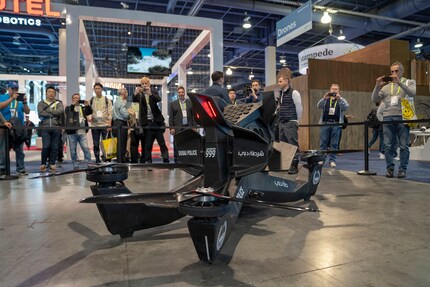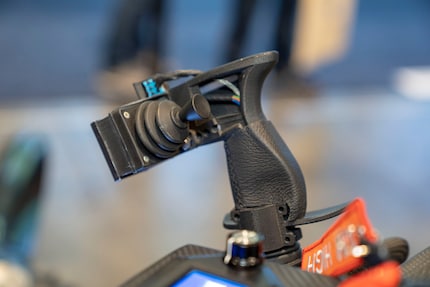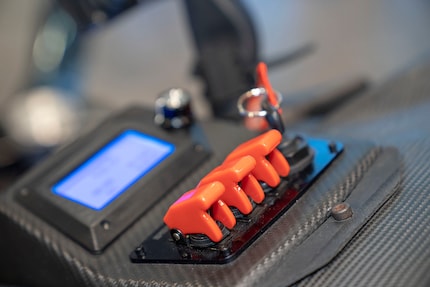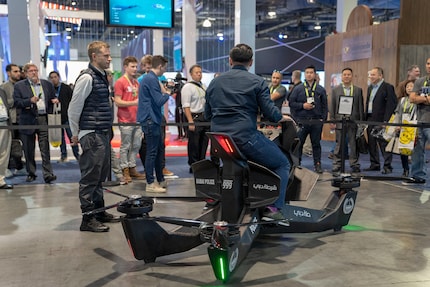Hoversurf S3: The flying motorbike is a reality. At last.
Drones are yesterday's news. So are self-driving cars. A Russian engineer has developed a flying motorbike and it's great.
Alex Atamanov has a stand at the CES in Las Vegas. Where other manufacturers and think tanks rely on eye-catching neon signs and loud music, as well as daring stand architecture, Alex uses cheap barrier tape made of black fabric and a printed A4 piece of paper, half-finished and set into a frame on a post.
Alex displays a hoverbike at his stand. A flying motorbike that he invented.

"I don't like paper," says Alex with a Russian accent.
He has been labelled the "Russian Elon Musk" in the international press. He stands at his stand in a white shirt, down gilet, suit trousers and black down gilet. In the interview, he seems shy and can't give much information about his flying motorbike, which is not allowed to fly in the halls of the CES. He doesn't want to say whether he thinks that's a bad idea.
But anyone can sit on it. Sometimes Alex also sits on his plane and lets the rotors roar.
In the saddle of the flying motorbike
"Very important: don't touch anything," says Alex on the way from the barrier tape to the hoverbike, which is officially called the Hoversurf S3.
The words "Dubai Police" are written on the matt black flying motorbike, as Dubai Police are already using the hoverbikes to rescue and search for missing persons. The Hoversurf S3 on display at Alex's stand is not a model, not a demo unit, but the real thing.

The Cockpit looks a bit like the handlebars of the Batpod from the Hollywood film "The Dark Knight Rises". Two joysticks, each with a small lever on it. You lie down in the saddle, which is covered with hexagonal cushions. The S3 gives the impression that it doesn't weigh a gram too much. The vehicle, whose body is made from a single piece of carbon fibre, must not weigh more than 114 kilos. This is because the Hoversurf S3 is approved by the US flight regulation authority FAA. In other words, you can buy one in the USA and then fly off.

There is a screen between the two steering joysticks, with a rotary knob next to it. This determines the maximum flight altitude. Everything from 10 centimetres to 6000 metres is possible. Then there are three toggle switches that are mysteriously labelled with abbreviations.
"I won't tell you what they're good for," says Alex with a grin.
Even if he seems a little shy in the interview, he blossoms when he can talk about his hoverbike. He wears heavy combat boots.
"I often have to switch the rotors on and off. I certainly can't get into the rotors when they're turning."
He flips a toggle switch and presses a button. The four rotors attached to the arms turn on. A humming sound. A light blast of air hits my legs. I can feel the power of the S3. There's a lot of power behind it. The S3 wants to work, wants to move. Alex turns the rotors up to exactly the point where the S3 remains on the ground.
After about a minute, the S3 feels familiar. I feel like I could get it off the ground safely. The bike stabilises itself in the air. After three days of instruction - no purchase may be completed without the corresponding course - anyone who can ride a bike should be able to master the Hoversurf and fly at up to 100 kilometres per hour for up to 50 minutes. Then the battery is empty.
I want to press all the buttons. Somewhere there will be a button to take off. It's not often that I'm so tempted to break the rules. The Hoversurf S3 is a dream, a vision of the future straight out of a 1960s science fiction film. Something I've been waiting for for ages, but didn't realise. I'm convinced: the world needs hoverbikes.
Alex probably already knows the look on my face too well. Probably from the mirror too. He switches off the rotors. I don't want to get off, but I have to. I've been sitting on the future and have to get back to the present. I don't want to.
The boy who built himself a flying bike
When Alex sits on the bike himself, he knows exactly how to distribute his weight so that he can make the rotors spin faster without taking off. The fun is written all over his face. Although his blond hair is slightly greying, there is a youthful mischief on his face. This is no Elon Musk, no great inventor, no visionary. This is a Russian boy with an idea. So he answers the question of why briefly and succinctly.
"This thing is a boyhood dream of mine."
He doesn't need to say any more. Anyone who hears this answer and sees him with his S3 knows what he means. Sure, Alex would be happy if he made a lot of money with his invention, but it's obvious that the whole hoversurf thing would be completely fine with him if there was just one bike in the world and he could fly around on it.
An interview with him? He's happy to talk and answer questions, but can't say much about the technological details.

"You can see why I want to keep a lot of things secret. Yesterday there were representatives from about three militaries and x number of industrialists," he says.
But some of it is printed on the one A4 sheet of paper. The battery has a capacity of 12.3 KWh and can be charged in 150 minutes. Each of the motors has an output of 30 kW, each propeller has three blades and a diameter of 120 cm. This gives the hoverbike a lift of 364 kilograms, 114 kilograms of which is the machine itself. In addition, the pilot weighs around 100 kilograms. The rest can be attached to a hook at the bottom of the S3. Rescue operations with stretchers or deliveries of relief supplies should not be a problem.
Alex does not mention armament. He feels uncomfortable when asked about it. Not because it is impossible to arm the hoverbike. Both the M249 Saw, the standard machine gun of an Apache helicopter, and the M61 Vulcan, the most widely used rotary machine gun, would be light enough to be attached to the S3. But Alex, listeners get the feeling, has somehow not thought about it. And probably doesn't want to think about it either, even though he realises that the military of this world are keen on his vehicle.
We say goodbye. I take another photo with my Huawei Mate 20 Pro.
"Is that the new Huawei?" asks Alex.
He asks if he can have a look at it. There's a man there who has invented a flying motorbike, and he finds the most interesting thing at the stand with his invention a journalist's mobile phone. I press it into his hand and say that I would swap it for a hoverbike. But Alex doesn't hear that because he has to show his colleagues the phone. Me and video producer Stephanie Tresch no longer understand the world. He tests the camera and briefly forgets that he is the man who will show us all what the future will look like.
Five minutes later, I have my mobile back. We leave the future behind us. For the rest of the day, we keep hearing ourselves saying "If we had a hoverbike now..."
You can find all articles about CES 2019 here.
Journalist. Author. Hacker. A storyteller searching for boundaries, secrets and taboos – putting the world to paper. Not because I can but because I can’t not.